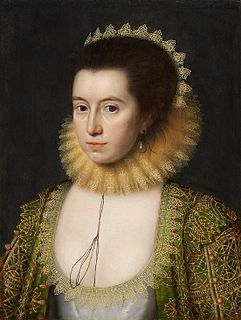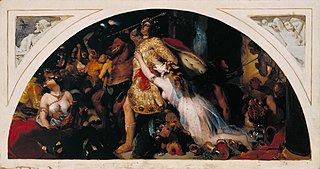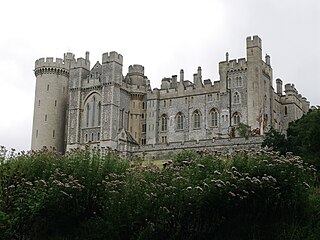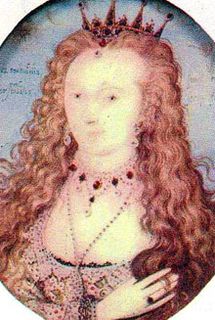
Lady Anne Clifford, Countess of Dorset, Pembroke and Montgomery, suo jure 14th Baroness de Clifford was an English peeress. In 1605 she inherited her father's ancient barony by writ and became suo jure 14th Baroness de Clifford. She was a patron of literature and as evidenced by her diary and many letters was a literary personage in her own right. She held the hereditary office of High Sheriff of Westmorland which role she exercised from 1653 to 1676.
Anne Stanley was an English noblewoman. She was the eldest daughter of the Earl of Derby and, through her two marriages, became Baroness Chandos and later Countess of Castlehaven. She was a distant relative of Elizabeth I of England and for some time was seen as a possible heiress to the English throne.

Comus is a masque in honour of chastity, written by John Milton. It was first presented on Michaelmas, 1634, before John Egerton, 1st Earl of Bridgewater, at Ludlow Castle in celebration of the Earl's new post as Lord President of Wales.
Anne Vaughan, Countess of Carbery was a daughter of George Savile, 1st Marquess of Halifax, and his first wife, Lady Dorothy Spencer.

de Lacy is the surname of an old Norman family which originated from Lassy, Calvados. The family took part in the Norman conquest of England and the later Norman invasion of Ireland. The name is first recorded for Hugh de Lacy (1020–1085). His sons, Walter and Ilbert, left Normandy and travelled to England with William the Conqueror. The awards of land by the Conqueror to the de Lacy sons led to two distinct branches of the family: the northern branch, centred on Blackburnshire and west Yorkshire was held by Ilbert's descendants; the southern branch of Marcher Lords, centred on Herefordshire and Shropshire, was held by Walter's descendants.

John Egerton, 1st Earl of Bridgewater KB, PC was an English peer and politician from the Egerton family.

Richard Vaughan, 2nd Earl of Carbery KB, PC, styled The Honourable from 1621 until 1628 and then Lord Vaughan until 1634, was a Welsh soldier, peer and politician.

Walter Devereux, 10th Baron Ferrers of Chartley, created 1st Viscount Hereford, KG was an English courtier and parliamentarian.
John Vaughan, 1st Earl of Carbery was a Welsh courtier and politician who sat in the House of Commons in 1601 and from 1621 to 1622. He served Robert Devereux, 2nd Earl of Essex, and later Prince Charles, heir to the throne of King James I. However, his career ended when the Prince acceded to the throne in 1625, and he later estimated that serving the Prince had cost him £20,000, which went unrecompensed.
Alice de Warenne, Countess of Arundel was an English noblewoman and heir apparent to the Earldom of Surrey. In 1305, she married Edmund FitzAlan, 9th Earl of Arundel.

Katherine Mortimer, Countess of Warwick was the wife of Thomas de Beauchamp, 11th Earl of Warwick KG, an English peer, and military commander during the Hundred Years War. She was a daughter and co-heiress of Roger Mortimer, 1st Earl of March and Joan de Geneville, Baroness Geneville.
Arcades is a masque written by John Milton and performed on 4 May 1634. The piece was written to celebrate the character of Alice Spencer, the Countess Dowager of Derby, widow of Ferdinando Stanley, 5th Earl of Derby, during her 75th birthday. The masque distinguishes Spencer as having a greater far superior to other noble women by titling Spencer as queen of a metaphorical Arcadia that is far superior to any other realm. The piece served as a basis for Milton's later masque, Comus.

Alice Holland, Countess of Kent, LG, formerly Lady Alice FitzAlan, was an English noblewoman, a daughter of the 10th Earl of Arundel, and the wife of the 2nd Earl of Kent, the half-brother of King Richard II. As the maternal grandmother of Anne de Mortimer, she was an ancestor of King Edward IV and King Richard III, as well as King Henry VII and the Tudor dynasty through her daughter Margaret Holland. She was also the maternal grandmother of Joan Beaufort, Queen of Scots.

Elizabeth Stanley, Countess of Huntingdon was an English noblewoman and writer who was third in line of succession to the English throne. She was the wife of Henry Hastings, 5th Earl of Huntingdon. She was also styled Lady Hastings of Hungerford and Lady Botreaux as her husband held both of these titles in addition to the Earl of Huntingdon.

Alice Spencer, Countess of Derby was an English noblewoman from the Spencer family and noted patron of the arts. Poet Edmund Spenser represented her as "Amaryllis" in his eclogue Colin Clouts Come Home Againe (1595) and dedicated his poem The Teares of the Muses (1591) to her.

Richard Herbert, 2nd Baron Herbert of Chirbury was an Anglo-Welsh Member of Parliament, a Royalist who fought with the rank of colonel in the English Civil War, and a peer whose membership of the House of Lords was curtailed by its abolition in 1649.
Alice Neville, Baroness FitzHugh was the wife of Henry FitzHugh, 5th Baron FitzHugh. She is best known for being the great-grandmother of Queen consort Catherine Parr and her siblings, Anne and William, as well as one of the sisters of Warwick the 'Kingmaker'. Her family was one of the oldest and most powerful families of the North. They had a long-standing tradition of military service and a reputation for seeking power at the cost of the loyalty to the crown as was demonstrated by her brother, the Earl of Warwick.

Frances Vaughan was the second wife of Richard Vaughan, 2nd Earl of Carbery. Her second son, John, became the 3rd earl following his father's death in 1686.
Elizabeth Butler, Duchess of Ormond and 2nd Baroness Dingwall reunited the Ormond estate as her maternal grandfather, Black Tom, 10th Earl of Ormond had it, by marrying James Butler, later Duke of Ormond, her second cousin once removed. She had inherited her share of the Ormond estate through her mother, Elizabeth Preston, who was Black Tom's daughter and only surviving child. Her husband had inherited his share from his grandfather Walter Butler, 11th Earl of Ormond, Black Tom's successor in the earldom. Her share was the bigger one and included Kilkenny Castle.
John Erskine, Earl of Mar was a Scottish landowner.












